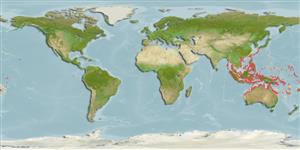>
Eupercaria/misc (Various families in series Eupercaria) >
Labridae (Wrasses) > Corinae
Etymology: Halichoeres: Greek, als, alis = salt + Greek, choiros = pig (Ref. 45335).
More on author: Bleeker.
Environment: milieu / climate zone / depth range / distribution range
Ekologi
marina revassocierade; djupintervall 1 - 15 m (Ref. 9710). Tropical; 32°N - 30°S, 91°E - 170°W
Indo-Pacific: from Bali, Indonesia and Western Australia to Micronesia and Samoa; north to Japan; south to Australia.
Size / Vikt / Age
Maturity: Lm ? range ? - ? cm
Max length : 14.0 cm TL hane/ej könsbestämd; (Ref. 129178)
Taggstrålar i ryggfenan (totalt): 9; Mjukstrålar i ryggfenan (totalt): 11-12; Taggstrålar i analfenan 3; Mjukstrålar i analfenan: 11 - 12; Ryggkotor: 25. Stripes on male body blue-green and orangish in life, becoming salmon pink and green anteriorly; a dark spot behind eye contained within a brown band that bifurcates posteriorly. Females with a small black spot on 1st interspinous membrane of dorsal fin, another between 2nd-3rd soft rays; a spot at the upper base of caudal fin. Anterior lateral line scales with 1-4 pores (usually 2). Pelvic fins of males reaching to or beyond the anus.
Found mostly on shallow coral reefs and rocky shores (Ref. 9823). Found solitary or in small groups on sheltered reefs over 15 m depth (Ref. 90102). Feed on small invertebrates such as polychaetes, copepods, isopods and forams (Ref. 1602).
Life cycle and mating behavior
Könsmognad | Reproduktion | Lek | Ägg | Fecundity | Larver
Distinct pairing during breeding (Ref. 205).
Randall, J.E., G.R. Allen and R.C. Steene, 1990. Fishes of the Great Barrier Reef and Coral Sea. University of Hawaii Press, Honolulu, Hawaii. 506 p. (Ref. 2334)
IUCN Red List Status (Ref. 130435)
Threat to humans
Harmless
Human uses
Akvarium: Offentliga akvarier
Ytterligare information
referenserVattenbrukVattenbruksprofilAvelslinjerGenetikElectrophoresesÄrftlighetSjukdomarBehandlingNutrientsMass conversion
Verktyg
Special reports
Download XML
Internet-källor
Estimates based on models
Preferred temperature (Ref.
123201): 25 - 29.3, mean 28.6 °C (based on 2325 cells).
Phylogenetic diversity index (Ref.
82804): PD
50 = 0.5000 [Uniqueness, from 0.5 = low to 2.0 = high].
Bayesian length-weight: a=0.01288 (0.00791 - 0.02097), b=3.19 (3.05 - 3.33), in cm total length, based on LWR estimates for this species & Genus-body shape (Ref.
93245).
Trofisk nivå (Ref.
69278): 2.9 ±0.2 se; based on diet studies.
Resiliens (Ref.
120179): Hög, lägsta populationsfördubblingstid mindre än 15 månader (Preliminary K or Fecundity.).
Fishing Vulnerability (Ref.
59153): Low vulnerability (10 of 100).
Nutrients (Ref.
124155): Calcium = 115 [65, 199] mg/100g; Iron = 0.831 [0.474, 1.554] mg/100g; Protein = 18.3 [15.4, 20.5] %; Omega3 = 0.142 [0.088, 0.230] g/100g; Selenium = 20.8 [12.4, 37.8] μg/100g; VitaminA = 138 [42, 530] μg/100g; Zinc = 2.12 [1.44, 3.45] mg/100g (wet weight);
